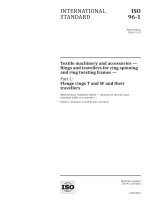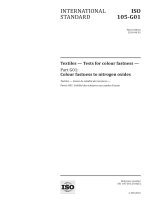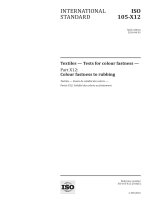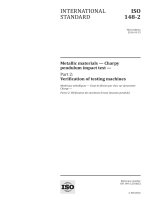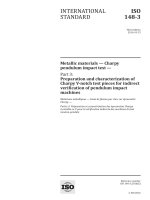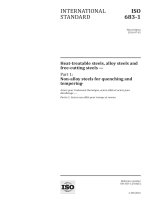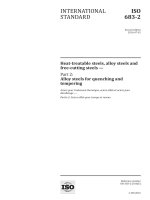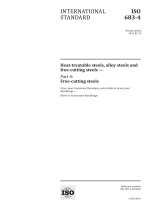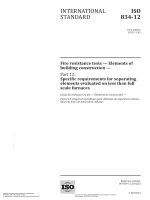Tiêu chuẩn iso 16900 12 2016
Bạn đang xem bản rút gọn của tài liệu. Xem và tải ngay bản đầy đủ của tài liệu tại đây (549.22 KB, 22 trang )
INTERNATIONAL
STANDARD
ISO
1 6900-1 2
First edition
2 01 6-05-1 5
Respiratory protective devices —
Methods of test and test equipment —
Part 1 2 :
Determination of volume-averaged
work of breathing and peak
respiratory pressures
Appareils de protection respiratoire — Méthodes d’essai et
équipement d’essai —
Partie 1 2: Détermination du travail respiratoire en fonction
du volume respiratoire et détermination des pics de pressions
respiratoires
Reference number
ISO 1 6900-1 2 : 2 01 6(E)
©
ISO 2 01 6
ISO 16900-12 :2 016(E)
COPYRIGHT PROTECTED DOCUMENT
© ISO 2016, Published in Switzerland
All rights reserved. Unless otherwise speci fied, no part of this publication may be reproduced or utilized otherwise in any form
or by any means, electronic or mechanical, including photocopying, or posting on the internet or an intranet, without prior
written permission. Permission can be requested from either ISO at the address below or ISO’s member body in the country of
the requester.
ISO copyright office
Ch. de Blandonnet 8 • CP 401
CH-1214 Vernier, Geneva, Switzerland
Tel. +41 22 749 01 11
Fax +41 22 749 09 47
www.iso.org
ii
© ISO 2016 – All rights reserved
ISO 16900-12 :2 016(E)
Contents
Page
Foreword ........................................................................................................................................................................................................................................ iv
Introduction ................................................................................................................................................................................................................................ vi
1
Scope ................................................................................................................................................................................................................................. 1
2
Normative references ...................................................................................................................................................................................... 1
3 Termsandde initions
f
..................................................................................................................................................................................... 1
4
Prerequisites ............................................................................................................................................................................................................ 2
5
General test requirements ......................................................................................................................................................................... 2
6
Principle ........................................................................................................................................................................................................................ 2
7
Apparatus ..................................................................................................................................................................................................................... 3
7.1
Breathing machine/metabolic simulator arrangement ...................................................................................... 3
7.2
RPD headform/RPD torso ............................................................................................................................................................. 3
7.3
Pressure measurements ................................................................................................................................................................. 3
7.4
Volume measurements ..................................................................................................................................................................... 3
7.5
Data acquisition ..................................................................................................................................................................................... 4
8
Test procedure ........................................................................................................................................................................................................ 4
9
Calculation of work of breathing (WOB)
10
..................................................................................................................................... 5
9.1
General ........................................................................................................................................................................................................... 5
9.2
Calculations ................................................................................................................................................................................................ 5
9.2 .1
Work of breathing ........................................................................................................................................................... 5
9.2 .2
Volume averaged pressure ...................................................................................................................................... 6
9.2 .3
Elastance ................................................................................................................................................................................. 6
Test report................................................................................................................................................................................................................... 7
Annex A (normative) Application of uncertainty of measurement ...................................................................................... 8
Annex B (informative) Pressure-volume plots and method of calculation of work of breathing ...... 10
© ISO 2 01 6 – All rights reserved
iii
ISO 16900-12 :2 016(E)
Foreword
ISO (the International Organization for Standardization) is a worldwide federation of national standards
bodies (ISO member bodies). The work of preparing International Standards is normally carried out
through ISO technical committees. Each member body interested in a subject for which a technical
committee has been established has the right to be represented on that committee. International
organizations, governmental and non-governmental, in liaison with ISO, also take part in the work.
ISO collaborates closely with the International Electrotechnical Commission (IEC) on all matters of
electrotechnical standardization.
The procedures used to develop this document and those intended for its further maintenance are
described in the ISO/IEC Directives, Part 1 . In particular the different approval criteria needed for the
different types of ISO documents should be noted. This document was drafted in accordance with the
editorial rules of the ISO/IEC Directives, Part 2 (see www.iso.org/directives) .
Attention is drawn to the possibility that some of the elements of this document may be the subject of
patent rights. ISO shall not be held responsible for identifying any or all such patent rights. Details of
any patent rights identi fied during the development of the document will be in the Introduction and/or
on the ISO list of patent declarations received (see www.iso.org/patents) .
Any trade name used in this document is information given for the convenience of users and does not
constitute an endorsement.
For an explanation on the meaning of ISO speci fic terms and expressions related to conformity
assessment, as well as information about ISO’s adherence to the WTO principles in the Technical
Barriers to Trade (TBT) see the following URL:
Foreword - Supplementary information
The committee responsible for this document is ISO/TC 94,
equipm ent,
Subcommittee SC 15,
Person al safety — Protective clothin g an d
Respiratory protective devices.
ISO 16900 consists of the following parts, under the general title
Respiratory protective devices —
Meth ods of test an d test equipm ent:
—
Part 1 : Determin ation of inward leakage
—
Part 2: Determ in ation of breathin g resistan ce
—
Part 3: Determination of particle filter penetration
—
Part 4: Determination of gas filter capacity and migration, desorption and carbon monoxide
dyn am ic testin g
—
Part 5: Breathing machine, metabolic simulator, RPD headforms and torso, tools and verification tools
—
Part 6: Mech anical resistan ce/stren gth of compon ents an d conn ection s
—
Part 7: Practical perform an ce test m eth od
—
Part 8: Measurement of RPD air flow rates of assisted filtering RPD
—
Part 9: Determination of carbon dioxide content of the inhaled gas
—
Part 10: Resistance to ignition, flame, radiant heat and heat
—
Part 11: Determination of field of vision
—
Part 1 2: Determin ation of volum e-averaged work of breathin g an d peak respiratory pressures
—
Part 1 3: RPD usin g regen erated breath able gas an d special application m inin g escape RPD: Con solidated
test for gas concentration, temperature, humidity, work of breathing, breathing resistance, elastance
an d duration
iv
© ISO 2 01 6 – All rights reserved
ISO 16900-12 :2 016(E)
— Part 14: Measurement of sound level
© ISO 2016 – All rights reserved
v
ISO 16900-12 :2 016(E)
Introduction
This part of ISO 16900 is intended as a supplement to the respiratory protective devices (RPD)
performance standard. Test methods are speci fied for complete devices or parts of devices that are
intended to comply with the performance standards. If deviations from the test method given in this
part of ISO 16900 are necessary, these deviations will be speci fied in the performance standards.
The following de finitions apply in understanding how to implement an ISO International Standard and
other normative ISO deliverables (TS, PAS, I WA) :
—
“shall” indicates a requirement;
—
“should” indicates a recommendation;
— “may” is used to indicate that something is permitted;
—
“can” is used to indicate that something is possible, for example, that an organization or individual
is able to do something.
3.3.1 of the ISO/IEC Directives, Part 2 (sixth edition, 2011) de fines a requirement as an “expression in
the content of a document conveying criteria to be ful filled if compliance with the document is to be
claimed and from which no deviation is permitted.”
3.3.2 of the ISO/IEC Directives, Part 2 (sixth edition, 2011) de fines a recommendation as an “expression
in the content of a document conveying that among several possibilities, one is recommended as
particularly suitable, without mentioning or excluding others, or that a certain course of action is
preferred, but not necessarily required, or that (in the negative form) a certain possibility or course of
action is deprecated, but not prohibited.”
vi
© ISO 2 01 6 – All rights reserved
INTERNATIONAL STANDARD
ISO 16900-12 :2 016(E)
Respiratory protective devices — Methods of test and test
equipment —
Part 1 2 :
Determination of volume-averaged work of breathing and
peak respiratory pressures
1
Scope
This part of ISO 16900 speci fies the test methods for determining the volume-averaged work of
breathing and peak respiratory pressures imposed by the respiratory protective device (RPD).
Elastic work, elastic physiological effects, and information on physiological effects of work of breathing
(WOB) are speci fied in ISO 16976-4 and are not included in this test method.
2
Normative references
The following documents, in whole or in part, are normatively referenced in this document and are
indispensable for its application. For dated references, only the edition cited applies. For undated
references, the latest edition of the referenced document (including any amendments) applies.
I SO
16972 ,
Respiratory protective devices — Terms, definitions, graphical symbols and units of
measurement
I SO 169 0 0 -5 , 1)
Respiratory protective devices — Methods of test and test equipment — Part 5: Breathing
machine, metabolic simulator, RPD headforms and torso, tools and verification tools
3Termsandde initions
f
For the purposes of this document, the terms and de finitions given in ISO 16972 and the following apply.
3 .1
breathing frequency
number of breaths taken in a minute
Note 1 to entry: Expressed in breaths per minute.
3 .2
elastance
E
press ure change resulting from a volume change
Note 1 to entry: Expressed in kPa/l.
3.3
tidal volume
VT
size of a breath
Note 1 to entry: Expressed in litres.
1)
To be published.
© ISO 2 0 1 6 – All rights reserved
1
ISO 16900-12 :2 016(E)
3 .4
volume-averaged pressure
WOB/
VT
work for a breath divided by its tidal volume (3 . 3)
Note 1 to entry: Expressed in kPa.
Note 2 to entry: The
4
V can be determined separately for an inspiration, for an expiration, or for a
WOB/ T
whole bre ath .
Prerequisites
The performance standard shall indicate the conditions of the test. This includes the following:
a)
number of specimens;
b) operating parameters speci fic to RPD;
c) selection and types of support such as RPD headform/torso;
d) any prior conditioning or testing;
e)
minute ventilation;
f)
temperature(s) at which tests are to be performed.
5
General test requirements
Unless otherwise speci fied, the values stated in this part of ISO 16900 are expressed as nominal values.
Except for temperature limits, values which are not stated as maxima or minima shall be subject to a
tolerance of ±5 %. Unless otherwise speci fied, the ambient temperature for testing shall be between 16 °C
and 32 °C and (50 ± 30) % RH. Any temperature limits speci fied shall be subject to an accuracy of ±1 °C.
Where the assessment of the pass/fail criterion depends on a measurement, an uncertainty of
measurement as speci fied in Annex A shall be reported.
6
Principle
The RPD is fitted to a headform/torso and is operated at the manufacturer’s minimum condition, unless
speci fied otherwise by the performance standards.
The breathing machine or metabolic simulator, as applicable, is operated at a combination of tidal
volume and breathing frequency, in accordance with the relevant performance standard. The work of
breathing is calculated from recorded measurements of volume and pressure. These recordings will
also provide peak pressures values.
Validation of work of breathing measurements and calculations is performed using the veri fication
ori fices as speci fied in ISO 16900-5.
Validation of the correct functioning of the breathing machine/metabolic simulator is performed using
the validation ori fices speci fied in ISO 16900-5. Validation is satisfactory when the WOB calculations
give results which are in accordance with the data shown in Table 1 .
2
© ISO 2 01 6 – All rights reserved
ISO 16900-12 :2 016(E)
7
Apparatus
7.1
Breathing machine/metabolic simulator arrangement
A breathing machine or metabolic simulator meeting the speci fications of ISO 16900-5 shall be used. An
e x a mp le o f a s e tup i s s ho w n i n F i g u re 1 .
Key
1
h e ad fo rm o r o th e r s u i tab l e m e ch an i s m to h o l d RP D u n d e r te s t
2
b re ath i n g m ach i n e
3
d i s p l ace m e n t s e n s o r
pressure pickup in the airway opening
4
5
p re s s u re tran s d u ce r, i f s e p arate fro m 4
6
d ata acq u i s i ti o n d e vi ce
NO TE
D o u b l e - h e ad e d a r r o ws a n d s i n g l e - h e a de d a r r o ws i n d i c a te th e m o ti o n o f th e b r e ath i n g m ac h i n e p i s to n
and the direction of gas flow, respectively.
Figure1—Simpli iedschematicofasetuptomeasureworkofbreathing
f
7.2
RPD headform/RPD torso
Appropriate RPD headform/RPD torso, as speci fied in ISO 16900-5, shall be used. For RPD with
respiratory interface Class E (see the performance standards), it can be necessary, depending on the
design, to adjust the test setup to simulate the volume taken up by the arms and legs of the wearer
because it can affect the gas flow management of the RPD. It can be necessary to adapt the RPD to allow
p l ac e me n t o f s e n s o r s a nd p ro b e s .
7.3
A
Pressure measurements
d i ffe re n ti a l
p re s s u re
tra n s duc e r
me a s u re s
the
p o s i ti ve
a nd
ne gati ve
p re s s u re s
re l ati ve
to
a mb ie n t
pressure generated during breathing. This respiratory pressure shall be measured using a pressure
pickup in the RPD headform or mouthpiece attachment as speci fied in ISO 16900-5. The pressure
measurement system shall be able to measure at frequencies up to 50 Hz with less than 3 dB damping.
7.4
T he
Volume measurements
vo lu me
shal l
be
de te r m i ne d
fro m
p i s to n
d i s p l ac e me n t
wh i ch
is
me a s u re d
us ing
a
d i s p l ace me n t
s e n s o r mo u n te d o n the b re ath i n g m ach i ne .
© I S O 2 0 1 6 – Al l ri gh ts re s e rve d
3
ISO 16900-12 :2 016(E)
7.5
Data acquisition
Pressure and volume signals shall be acquired at a minimum of 100 Hz per channel.
8
Test procedure
8.1
Use the relevant validation ori fices as described in ISO 16900-5 to con firm that the measured work
of breathing (WOB) from the test system being used is within the tolerances shown in Table 1.
Fit the respiratory interface or complete RPD, in accordance with the information supplied by
the manufacturer, to the appropriate size of RPD headform/torso, and operate the RPD as given by the
prerequisites. The respiratory interface should be sealed to the headform where applicable (tight fitting).
8.2
Connect the breathing circuit to the RPD headform/torso.
8.3
If applicable, activate the RPD in accordance with the information supplied by the manufacturer
and immediately start the test and operate as speci fied in Clause 4.
8.4
Collect data at minute ventilations as given by the prerequisites. After stabilization, for any 10
8.5
consecutive breaths, perform ensemble averaging of these breaths, calculate the work of breathing and
the peak inspiratory and the peak expiratory pressures.
8.6
Remove the RPD from the headform/torso and repeat 8.2 to 8.5 for the required number of test
specimens.
Repeat 8.1.
8.7
Table 1 — Volume averaged pressure (WOB/VT
Minute
ventilation
a
l/min
10 ± 0,3
20 ± 0,4
35 ± 0,7
50 ± 1,0
65 ± 1,3
85 ± 1,7
105 ± 1,1
135 ± 1,4
Breathing
frequency
Tidal
volume
min−1
10,0
20,0
23,3
25,0
32,5
34,0
42,0
45,0
(VT )
l
1,0
1,0
1,5
2,0
2,0
2,5
2,5
3,0
)valuesforthetwoveri icationori ices
f
Ori iceA
f
WOB/VT
kPa
0,06 ± 0,01
0,22 ± 0,02
0,62 ± 0,03
1,22 ± 0,06
2,02 ± 0,10
3,39 ± 0,17
—
—
f
Ori iceB
f
Maximum
asymmetrya
%
8
5
5
5
5
5
5
8
WOB/VT
kPa
0,62 ± 0,03
1,05 ± 0,05
1,58 ± 0,08
2,60 ± 0,13
Maximum
asymmetrya
%
8
5
5
5
5
5
5
8
Asymmetry is calculated as the absolute value of the difference between one and the ratio of peak expiratory pressure
and peak inspiratory pressure, expressed in per cent.
NOTE
The veri fication procedure identi fies whether or not the breathing machine is capable of delivering
acceptable work of breathing results. Where work of breathing results are not within the acceptable limits, it
indicates a fault in the breathing machine or metabolic simulator and pipework. Common faults that can cause a
deviation of the work of breathing results from the values given in Table 1 include the following:
— a leak in the system;
— too many sharp bends or right angle elbows in the pipework;
4
© ISO 2016 – All rights reserved
ISO 16900-12 :2 016(E)
—
f
low restrictions in the pipework;
—
incorrect wave form (not sinusoidal) ;
—
incorrect calculations.
9
Calculation of work of breathing (WOB)
9.1
General
Work of breathing (WOB) is calculated over the averaged breathing cycles and is calculated from the
pressure difference between the airway opening and outside of the RPD and the volume.
A pressure-volume plot is shown in Figure 2 . The volume is plotted along axis A and the pressure is
plotted along axis B . Points C and D represent the volume at the start and end of inspiration, i.e. points
of no flow. The inspiration follows the line CGD and the expiration follows the line DHC. The tidal volume
(
VT ) is the absolute value of volume difference between points E and F. Annex B provides more detailed
information.
Key
A
volume axis
G
lowest pressure during inspiration
B
pressure axis
H
highest pressure during expiration
C
start of inspiration
I
D
end of inspiration
J
peak inspiratory pressure
peak expiratory pressure
E
volume at the start of inspiration
K
peak-to-peak pressure
F
volume at end of inspiration
NO TE
The pressure at point C is shown as zero, but it can be positive, zero, or negative.
Figure2—Typicalpressure-volumeplotforanRPDwithlowresistanceandelastance
f
9.2
9.2 .1
Calculations
Work of breathing
© ISO 2 01 6 – All rights reserved
5
ISO 16900-12 :2 016(E)
The work of breathing (WOB) is calculated separately for the inspiration (WOB in)
and the expiration
(WOB ex) . WOB in is calculated as the area inside the lines CGDC as shown in Figure 2 .
Similarly, the
WOB ex is the area DHCD. The total WOB (WOB tot) is the sum of WOB in and WOB ex [see Formula (1)] .
WOB tot = WOB in + WOB ex
9.2 .2
(1)
Volume averaged pressure
The inspiratory volume averaged pressure (WOB in/VT ) is calculated as shown in Formula (2) :
WOB in / VT =
WOB in
(2)
VT
The expiratory volume averaged pressure (WOB ex/VT ) is calculated as shown in Formula (3) :
WOB ex / VT =
WOB ex
(3)
VT
The total volume averaged pressure (WOB/
the tidal volume (WOB tot/
VT ) is calculated as the total work of breathing divided by
VT ) as shown in Formula (4) :
WOB tot
WOB tot / VT =
VT
(4)
In Figure 2 , point G is the lowest pressure during inspiration. Point H is the highest pressure during the
expiration. The peak pressure during an inspiration is the difference between the pressures at points
G and C (shown as I ) . The peak pressure during an expiration is the difference between the pressures
at points H and D (shown as J ) . The overall peak-to-peak pressure (K) is the difference between the
pressures at points H and G.
The tidal volume,
VT, is calculated as shown in Formula (5 ) :
VT = VF − VE
(5 )
where
VT
is the tidal volume;
VF
is the volume at point F;
VE
is the volume at point E .
9.2 .3
Elastance
The elastance,
E, is calculated as shown in Formula (6) :
PC − PD
VT
E =
(6)
where
6
PC
is the pressure at point C;
PD
is the pressure at point D.
© ISO 2 01 6 – All rights reserved
ISO 16900-12 :2 016(E)
10 Test report
The test report shall include at least the following information:
a) information identifying the RPD (model, sizes);
b) operating parameters speci fic to RPD;
c)
number of specimens tested;
d) any prior conditioning or testing;
e)
the size(s) of RPD headforms/RPD torso;
f) combination of tidal volume and breathing frequency and resulting minute ventilation;
g)
for each test specimen
1) the inspiratory and expiratory work of breathing per volume,
2)
total work of breathing per volume,
3)
pressure at the start of an inspiration,
4) inspiratory pressure at point G,
5)
pressure at the start of the expiration,
6) expiratory pressure at point H,
7) peak inspiratory (I) and peak expiratory (J) pressures,
8)
peak-to-peak pressure (K) , and
9)
elastance;
h) any deviations from the method(s) and justi fication(s);
i)
uncertainty of measurement.
© ISO 2 01 6 – All rights reserved
7
ISO 16900-12 :2 016(E)
Annex A
(normative)
Application of uncertainty of measurement
A.1 Determination of compliance
In order to determine compliance or otherwise of the measurement made in accordance with this test
metho d, when comp ared to the s p eci fication limits given in the p erformance s tandard, the fol lowing
protocol shall be applied.
I f the tes t res u lt ±
the uncer tainty of meas urement,
U
, fal l s
completely ins ide or outs ide of the
s p eci fication zone for the p ar ticu lar tes t given in the p erformance s tandard, then the res ult shal l b e
deemed to be a straightforward pass or fail (see Figures A.1 and A. 2) .
Key
1
lower speci ficatio n limit
2
sp eci fication zone
3
upper speci ficatio n limit
4
uncertainty of measurement,
5
measured value
U
Figure A.1 — Result pass
8
© ISO 2 01 6 – All rights reserved
ISO 16900-12 :2 016(E)
Key
1
lower speci fication limit
2
speci ficatio n zone
3
upper speci fication limit
4
uncertainty of measurement,
5
measured value
U
Figure A.2 — Result fail
I f the tes t res ult ± the uncer tainty of meas urement,
U
, overlap s a s p eci fication l imit value (upp er or
lower) for the particular test given in the protective device standard, then the assessment of pass or
fail shal l b e determined on the b as is of s afety for the wearer of the device, that is , the res u lt shal l b e
deemed to be a fail (see Figure A. 3) .
Key
1
lower speci fication limit
2
speci ficatio n zone
3
upper speci fication limit
4
uncertainty of measurement,
5
measured value
U
Figure A.3 — Result fail
© ISO 2 01 6 – All rights reserved
9
ISO 16900-12 :2 016(E)
Annex B
(informative)
Pressure-volume plots and method of calculation of work of
breathing
B.1 Pressure-volume plots
The amount of work required to take a breath when wearing an RPD can be calculated from recordings
of pressure and volume. The easiest way to calculate this is from a plot that shows how the pressure
varies with volume. Figure B .1 shows such a pressure-volume plot. This idealized plot could be from
an RPD that has only flow resistance, e.g. from an unassisted filtering RPD at low-minute ventilation or
from the loop from a veri fication ori fice. The volume is plotted along axis A and pressure is plotted along
axis B. Points C and D represent the start and end of inspiration, i.e. points of no flow. During inspiration,
the pressure typically drops and during expiration, it increases. In Figure B .1, the inspiration follows
the line CGD and the expiration follows the line DHC . A complete breath will form a loop.
The tidal volume (
VT )
is the difference between the volume at points E and F. Point G is the lowest
pressure during inspiration. Point H is the highest pressure during expiration. The peak pressure
during an inspiration is the difference between the pressures at points G and C (shown as arrow I ) . The
peak pressure during expiration is the difference between the pressures at points H and D (shown as
arrow J ) . The overall peak-to-peak pressure (shown as arrow K) is the difference between the pressures
at points H and G.
Key
A
volume axis
G
lowest pressure during inspiration
B
pressure axis
H
highest pressure during expiration
C
start of inspiration
I
D
end of inspiration
J
peak inspiratory pressure
peak expiratory pressure
E
volume at the start of inspiration
K
peak-to-peak pressure
F
volume at end of inspiration
NOTE
The pressure at point C is shown as zero, but it can be positive, zero, or negative.
FigureB.1—Pressure-volumeplotforanRPDwithlowresistance,withzeroelastance
f
10
© ISO 2 01 6 – All rights reserved
ISO 16900-12 :2 016(E)
B.2
Characteristics noted in pressure-volume plots
There are several characteristics that can be noted in a pressure-volume plot.
A pressure-volume plot from an unassisted filtering RPD can be expected to have the characteristics
in Figure B . 2 . At the start of the inspiration (point C), the pressure is zero and as f low increases, the
f low resistance in the RPD (e.g. from filter, check valve, and gas passage) generates a pressure drop
that makes the pressure inside the respiratory interface go negative. At the end of the inspiration,
the pressure comes back to zero. During the expiration, the flow resistance in the check valve and
gas passages generates a pressure drop such that the pressure inside the respiratory interface goes
positive. Note that the inspiratory and expiratory pressure drops are not the same.
Key
A
volume axis
B
pressure axis
C
start of inspiration
D
end of inspiration
FigureB.2—Pressure-volumeplotfromanunassistedilteringRPD
f
An assisted filtering RPD can make it more comfortable to breathe and can apply a positive starting
pressure. The pressure-volume plot for such an RPD is shown in Figure B . 3 . The pressure at the start of
inspiration can be seen to be well above zero. In this example, the pressure drops below zero (negative
pressure) just after the mid-point of the inspiration.
© ISO 2 01 6 – All rights reserved
11
ISO 16900-12 :2 016(E)
Key
A
volume axis
B
pressure axis
C
start of inspiration
D
end of inspiration
FigureB.3—Pressure-volumeplotfromanassistedilteringRPD
f
Figure B .4 shows an example of s upplied breathable gas RPD not us ing compres sed gas . C losed- circuit
RPD can show this type of WOB diagram. In the example shown, the pressure at the start of inspiration
was well above zero, but there was a sharp negative pressure spike. In this example, it was caused by
the performance characteristics of the valve. While the point F mid-way along the inspiration curve
is the lowest pressure during the inspiration cycle, the lowest peak inspiratory pressure is de fined as
p oint E .
It can be seen that the pres s ure at p oint D is lower than at point C . T his indicates an elas tance in the
closed-circuit RPD, commonly caused by spring-loaded bellows or bags and/or hoses that shorten or
lengthen from pres s ure changes .
12
© I SO 2 0 1 6 – All rights reserved
ISO 16900-12 :2 016(E)
Key
A
volume axis
B
pressure axis
C
start of inspiration
D
end of inspiration
E
low-pressure point
F
low-pressure point
FigureB.4—Pressure-volumeplotfromasuppliedbreathablegasRPD,notusingcompressed
breathable gas
Figure B . 5 shows an example of a s upplied breathable gas RPD us ing compres sed breathable gas . I n this
particular pressure-volume plot, the pressure stayed above zero throughout the breath.
© I SO 2 0 1 6 – All rights reserved
13
ISO 16900-12 :2 016(E)
Key
A
volume axis
B
pressure axis
C
start of inspiration
D
end of inspiration
FigureB.5—Pressure-volumeplotfromasuppliedbreathablegasRPD,usingcompressed
breathable gas
B.2 .1
General observations
The pressure needed to open an inspiratory valve tends to be independent of minute ventilation. This
is in contrast to the inspiratory pressure drop (caused by flow resistances) which increases with
increased minute ventilation. Thus, at low-minute ventilations, the peak inspiratory pressure tends to
be represented by point E in Figure B .4 while at higher minute ventilation, point F tends to be lower
than point E and thus, it will represent the peak inspiratory pressure rather than point E. Pressure
spikes from valves tend to be very short lasting and induce minimal work, while flow-resistive pressure
tends to build up gradually over an entire inspiration/expiration and induce much more work.
B.3
Method of calculation of work of breathing
The work of breathing (WOB) is calculated separately for the inspiration (WOB in)
and the expiration
(WOB ex) . WOB in is calculated as the area inside the lines CGDC as shown in Figure B .1 .
Similarly, the
WOB ex is the area DHCD. The total WOB (WOB tot) is the sum of WOB in and WOB ex .
WOB tot = WOB in + WOB ex
(B .1)
The inspiratory volume averaged pressure is calculated as WOB in/V T. The expiratory volume averaged
pressure is calculated as WOB ex/V T. The total volume averaged pressure (WOB/V T ) is calculated as the
total work of breathing divided by the tidal volume (WOB tot/V T ) .
Figure B .1
shows a pressure-volume plot for an RPD with only flow-resistive loads. In the absence of an
elastance in the RPD, the pressure at points C and D is the same.
Figure B .6
shows a pressure-volume plot for an RPD with flow resistance and elastance, compared
to Figure B .1 . The difference in pressures between points C and D is due to the elastance of the RPD
14
© ISO 2 01 6 – All rights reserved
